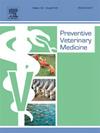Seasonal trend analysis of sporotrichosis with zoonotic potential
IF 2.4
2区 农林科学
Q1 VETERINARY SCIENCES
引用次数: 0
Abstract
Sporotrichosis is a zoonotic subcutaneous mycosis caused by fungi of the genus Sporothrix. It is considered a neglected disease, already reported in almost all Brazilian states in both animals and humans, highlighting the urgent need to understand the disease's behavior to guide public control and surveillance policies. Therefore, the objective of this study was to elucidate the hypothesis of seasonality in sporotrichosis based on the cases recorded in the municipality of Guarulhos, where notification is mandatory. For this purpose, animal sporotrichosis cases from 2016 to 2023 were provided by the Guarulhos Zoonosis Control Center, along with the date of the first consultation, and analyzed through observation of time series and their moving averages, and statistical comparisons between the seasons. Two models were used for time series decomposition: classical decomposition and seasonal trend decomposition (STL). Both models revealed a seasonal component with a uniform and repetitive pattern, showing little correlation with the residuals of the decomposition. The moving averages displayed annual fluctuations, with more cases recorded in the central months of the year (autumn and winter), supporting the hypothesis of a seasonal pattern of the disease. However, the comparison of case numbers between seasons using an ANOVA test indicated no statistical difference between the seasons, with p = 0.810. It is concluded there is a indication of potential seasonality, which reinforces the importance of implementing preventive and control measures targeting feline populations.
具有人畜共患潜力的孢子虫病的季节趋势分析
孢子菌病是一种由孢子菌属真菌引起的人畜共患皮下真菌病。它被认为是一种被忽视的疾病,巴西几乎所有州都有动物和人类感染的报告,这突出表明迫切需要了解这种疾病的行为,以指导公共控制和监测政策。因此,本研究的目的是根据瓜鲁洛斯市记录的病例来阐明孢子虫病的季节性假设,瓜鲁洛斯市的报告是强制性的。为此,收集Guarulhos人畜共患病控制中心提供的2016 - 2023年动物孢子虫病病例及首次会诊日期,通过观察时间序列及其移动平均值,以及季节间的统计比较进行分析。时间序列分解采用经典分解模型和季节趋势分解模型(STL)。两种模式都显示出具有统一和重复模式的季节成分,与分解残差的相关性很小。移动平均线显示出年度波动,在一年中的中心月份(秋季和冬季)记录的病例较多,这支持了该疾病具有季节性模式的假设。然而,使用ANOVA检验比较季节之间的病例数显示季节之间没有统计学差异,p = 0.810。结论是有潜在的季节性迹象,这加强了针对猫科动物种群实施预防和控制措施的重要性。
本文章由计算机程序翻译,如有差异,请以英文原文为准。
求助全文
约1分钟内获得全文
求助全文
来源期刊

Preventive veterinary medicine
农林科学-兽医学
CiteScore
5.60
自引率
7.70%
发文量
184
审稿时长
3 months
期刊介绍:
Preventive Veterinary Medicine is one of the leading international resources for scientific reports on animal health programs and preventive veterinary medicine. The journal follows the guidelines for standardizing and strengthening the reporting of biomedical research which are available from the CONSORT, MOOSE, PRISMA, REFLECT, STARD, and STROBE statements. The journal focuses on:
Epidemiology of health events relevant to domestic and wild animals;
Economic impacts of epidemic and endemic animal and zoonotic diseases;
Latest methods and approaches in veterinary epidemiology;
Disease and infection control or eradication measures;
The "One Health" concept and the relationships between veterinary medicine, human health, animal-production systems, and the environment;
Development of new techniques in surveillance systems and diagnosis;
Evaluation and control of diseases in animal populations.
 求助内容:
求助内容: 应助结果提醒方式:
应助结果提醒方式:


